Cisco Crosswork Optimization Engine Data Sheet
Available Languages
Bias-Free Language
The documentation set for this product strives to use bias-free language. For the purposes of this documentation set, bias-free is defined as language that does not imply discrimination based on age, disability, gender, racial identity, ethnic identity, sexual orientation, socioeconomic status, and intersectionality. Exceptions may be present in the documentation due to language that is hardcoded in the user interfaces of the product software, language used based on RFP documentation, or language that is used by a referenced third-party product. Learn more about how Cisco is using Inclusive Language.
Cisco Crosswork Optimization Engine provides real-time network optimization capabilities that allow operators to effectively maximize network utility as well as increase service velocity using real-time traffic engineering and proactive optimization.
Network operators are facing challenges to support the exponential growth of network traffic while addressing the pressure to efficiently run network operations. Providing quick service and network resolutions is vital for the business to remain viable. Network operators need a toolset to help automate bandwidth optimization and steer traffic efficiently with minimal operator intervention.
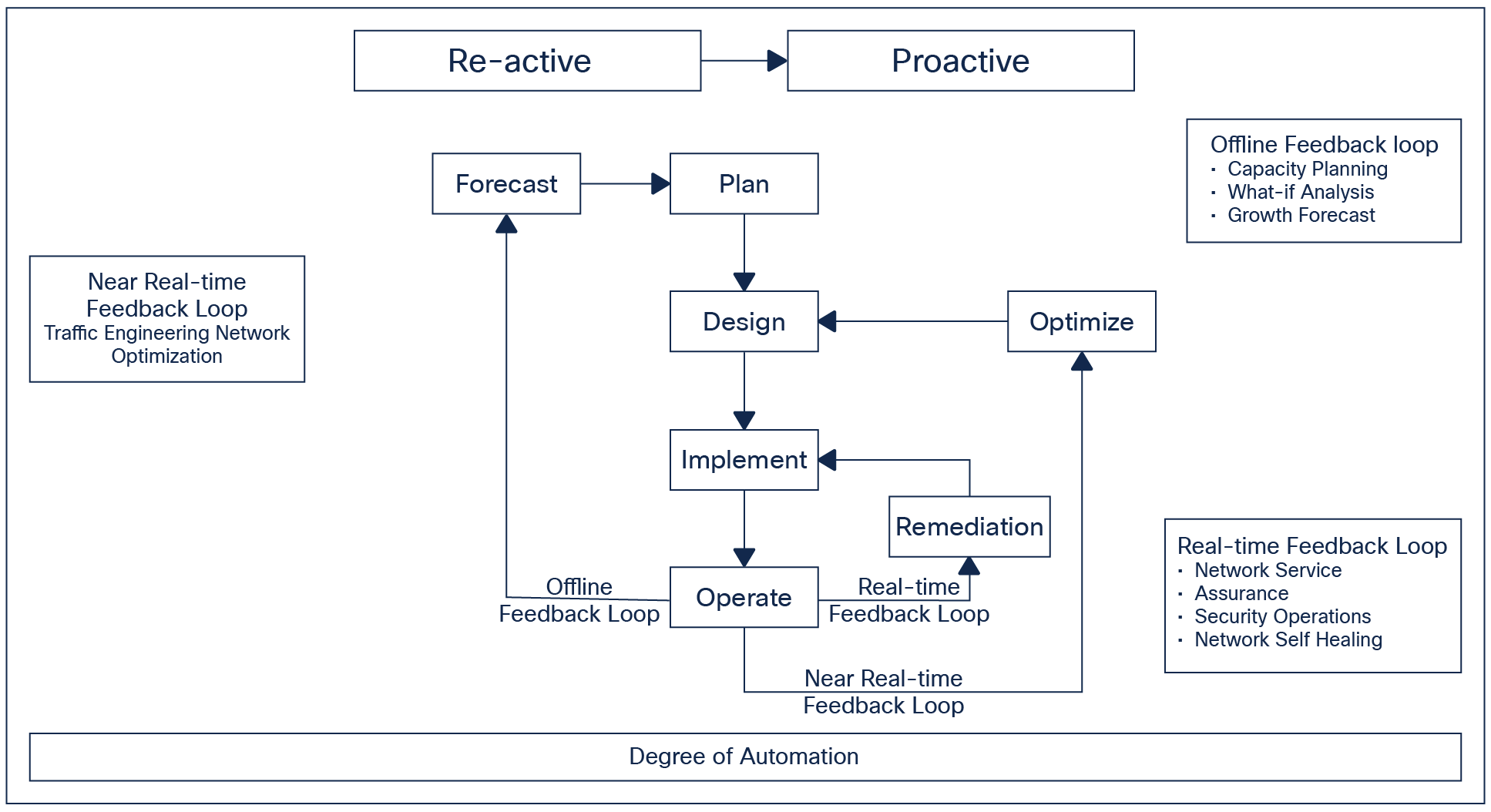
Figure of network development lifecycle with related actions for each phase
In a typical network development lifecycle, there is always a feedback loop that is traditionally done manually through human intervention. With network automation, the objective is to automate the feedback loop to enable quicker reaction to network events and faster determination on actions to perform on the network, while preserving operator intent in the network.
Looking at the network operation lifecycle above, Crosswork Optimization Engine is built to fulfill the need for a closed-loop optimization cycle as described under “Near Real-Time Feedback Loop.” Through Crosswork Optimization Engine, the operator would be able to define the optimization intent, implement the intent, and continuously monitor, track, and react to maintain the original intent.
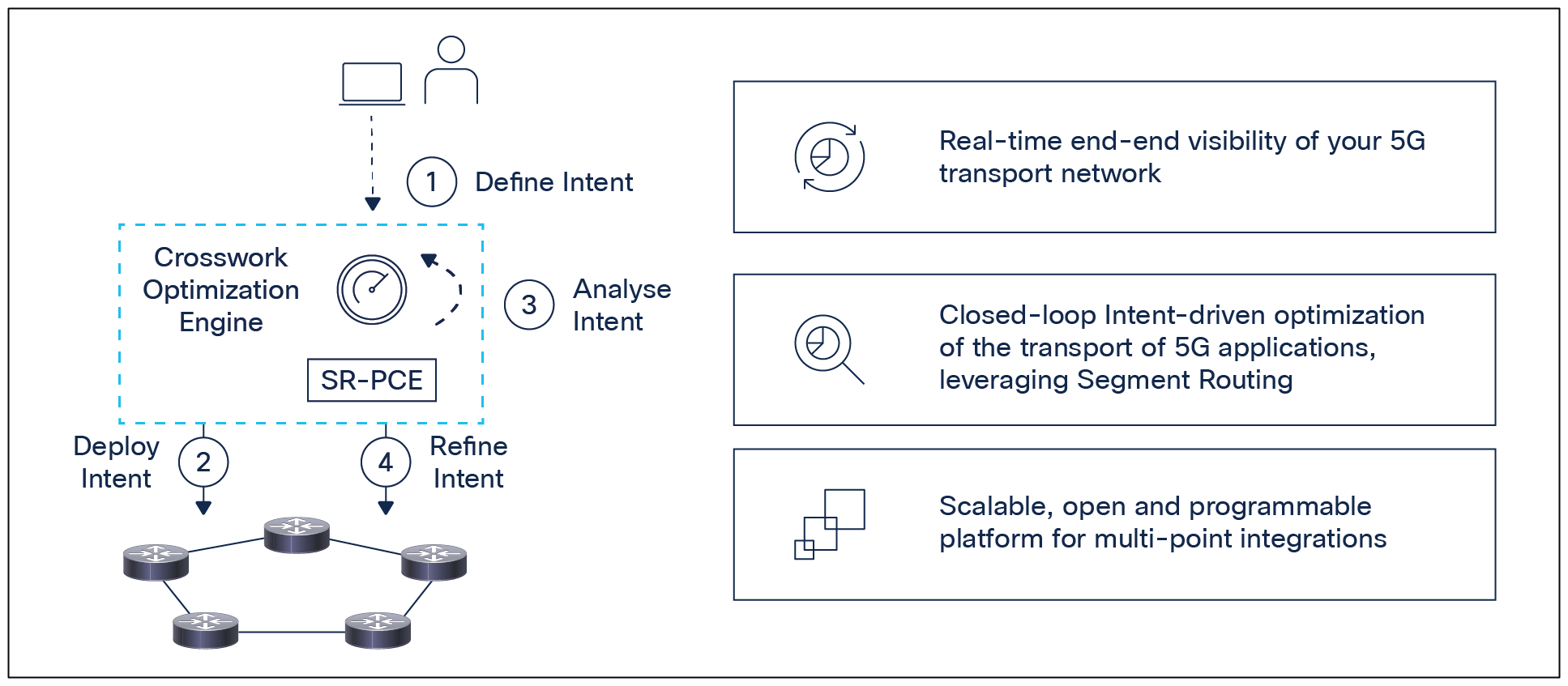
Crosswork Optimization Engine at a glance
Table 1. Crosswork Optimization Engine Features and Associated Benefits at a glance
| Feature |
Benefit |
| Topology auto-discovery |
Based on IETF-standard BGP-LS to automatically discover IP topology across multiple vendors. |
| Closed-loop feedback |
Leveraging real-time protocols such as BGP-LS and PCEP, Crosswork Optimization Engine enables closed-loop tracking of network state, reacting quickly to changes in the network conditions. Enabling closed-loop automation to enable a self-healing network. |
| Dynamic SLA management |
Industry-proven Segment Routing optimized algorithm to manage SLA objectives dynamically based on defined intent. |
| Real-time visualization |
Enables real-time visibility of the network, constantly in sync with the current state to provide true representation of the underlying infrastructure. |
| SRv6 discovery and visualization |
Discovery and visualization of SRv6 networks, policies, and topology information. |
| FlexAlgo discovery and visualization |
Discovery and visualization of FlexAlgo device participation, elected definitions including metric type, include/exclude affinities, advertisement, and priority. |
| SR policy lifecycle management |
Simple-to-use GUI to drive CRUD operation of Segment Routing Traffic Engineering (SR-TE) policies. |
| Tree-SID Topology Visualization and Provisioning |
Discovery and Visualization of Tree-SID network and provisioned policies, including path visualization and policy details. Provision and dynamically discover your static Tree-SIDs using COE. |
| RSVP-TE tunnel lifecycle management |
Simple-to-use GUI to drive CRUD operations of RSVP-TE tunnels. |
| API framework |
Open, publicly documented APIs enables operators to develop your own applications based on predefined API. |
| Bandwidth Feature pack |
Enables user to leverage additional bandwidth management–related use cases. |
Real-time, multivendor visibility
End-to-end visibility is important to any network operator to run their network effectively. Crosswork Optimization Engine provides not only this visibility, but also the ability to visualize the network across different layers (L2 adjacencies and L3 IP topology) and the relationship between each layer.
Crosswork Optimization Engine leverages IETF-standard BGP-LS protocol to discover IP networks automatically, with features such as:
● Up-to-date visibility: Maintains real-time, up-to-date visibility of the network infrastructure, which provides the network operator with true representation of the actual topology.
● Hierarchical view: Provides a hierarchical view of the topology, which enables operators to define the different levels of granularity in the topology visualization.
● Visualization of both SR-MPLS and SRv6 networks.
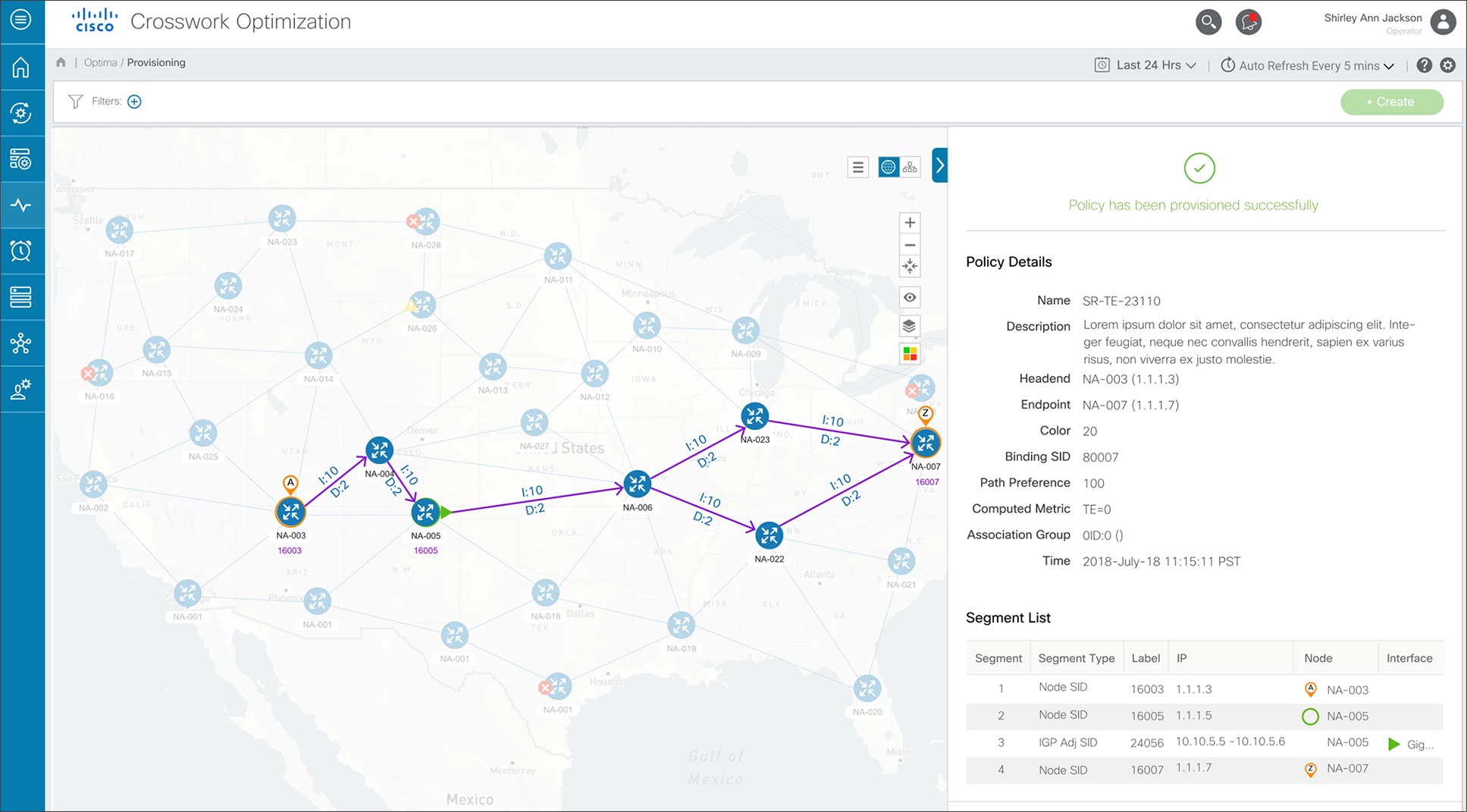
Policy Details Page in Crosswork Optimization Engine
SRv6 visualization:
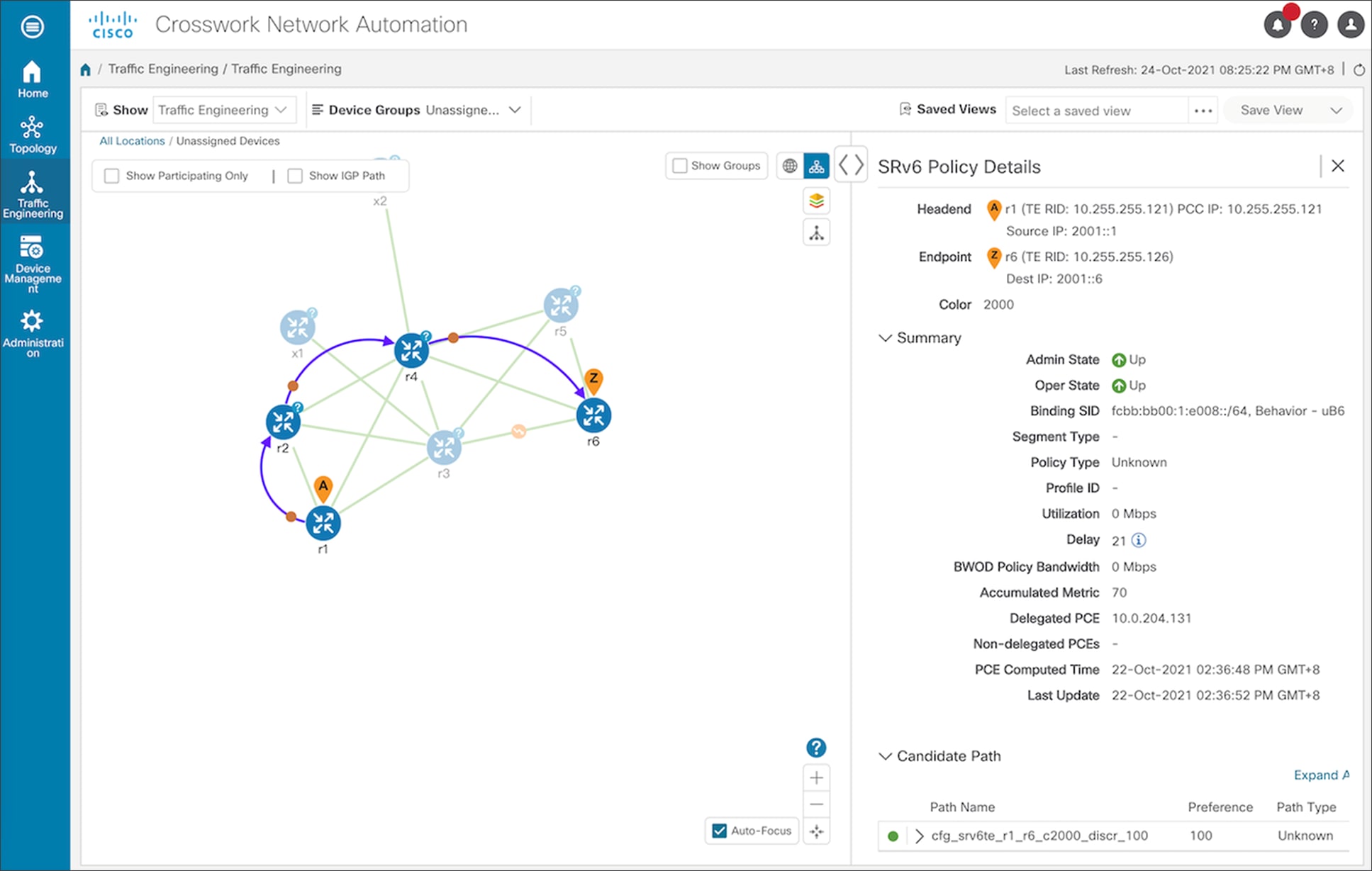
SRv6 Policy Details Page in Crosswork Optimization Engine
FlexAlgo visualization:
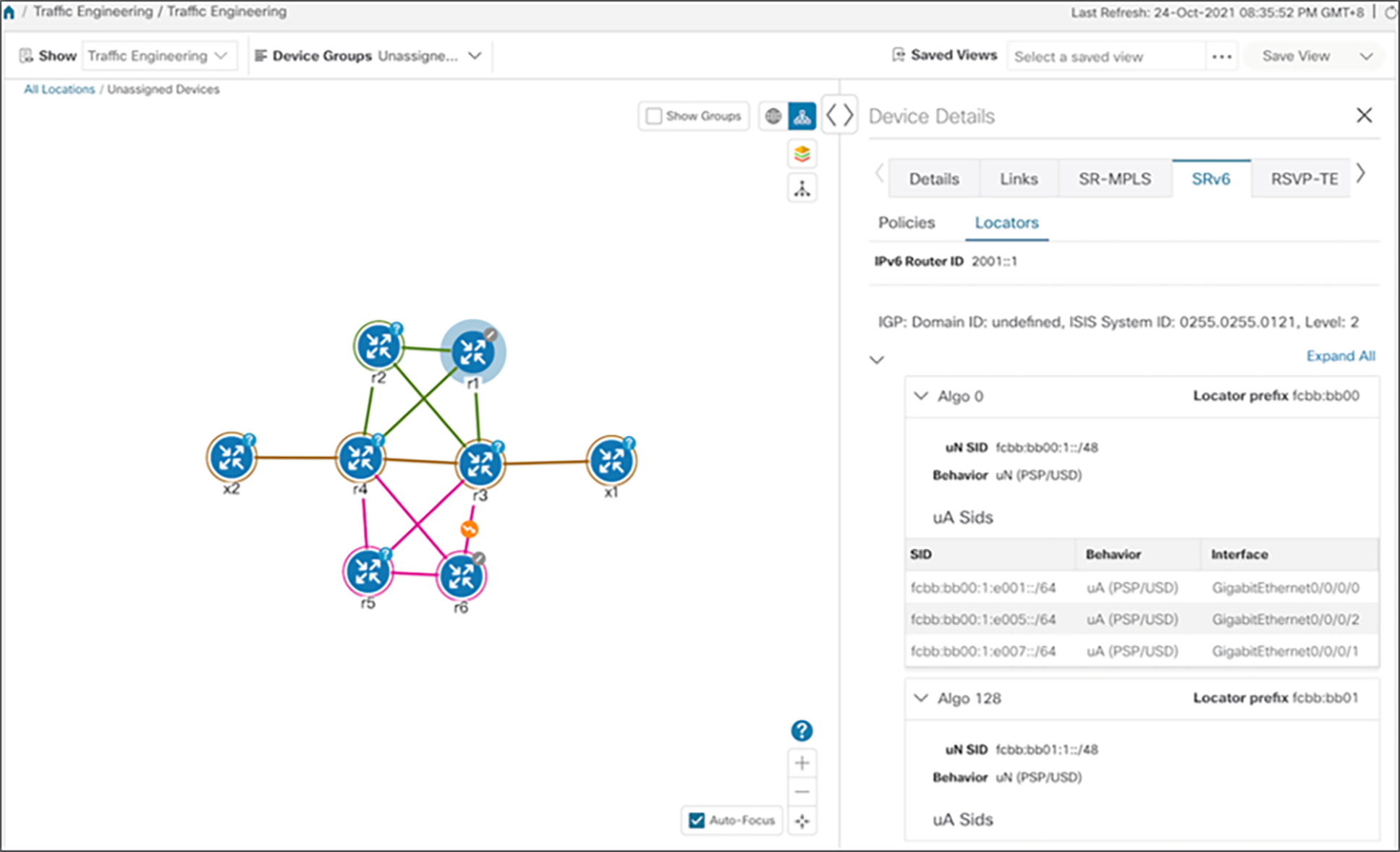
Example of two FlexAlgos displayed in the Crosswork Optimization Engine GUI
Tree-SID Visualization:
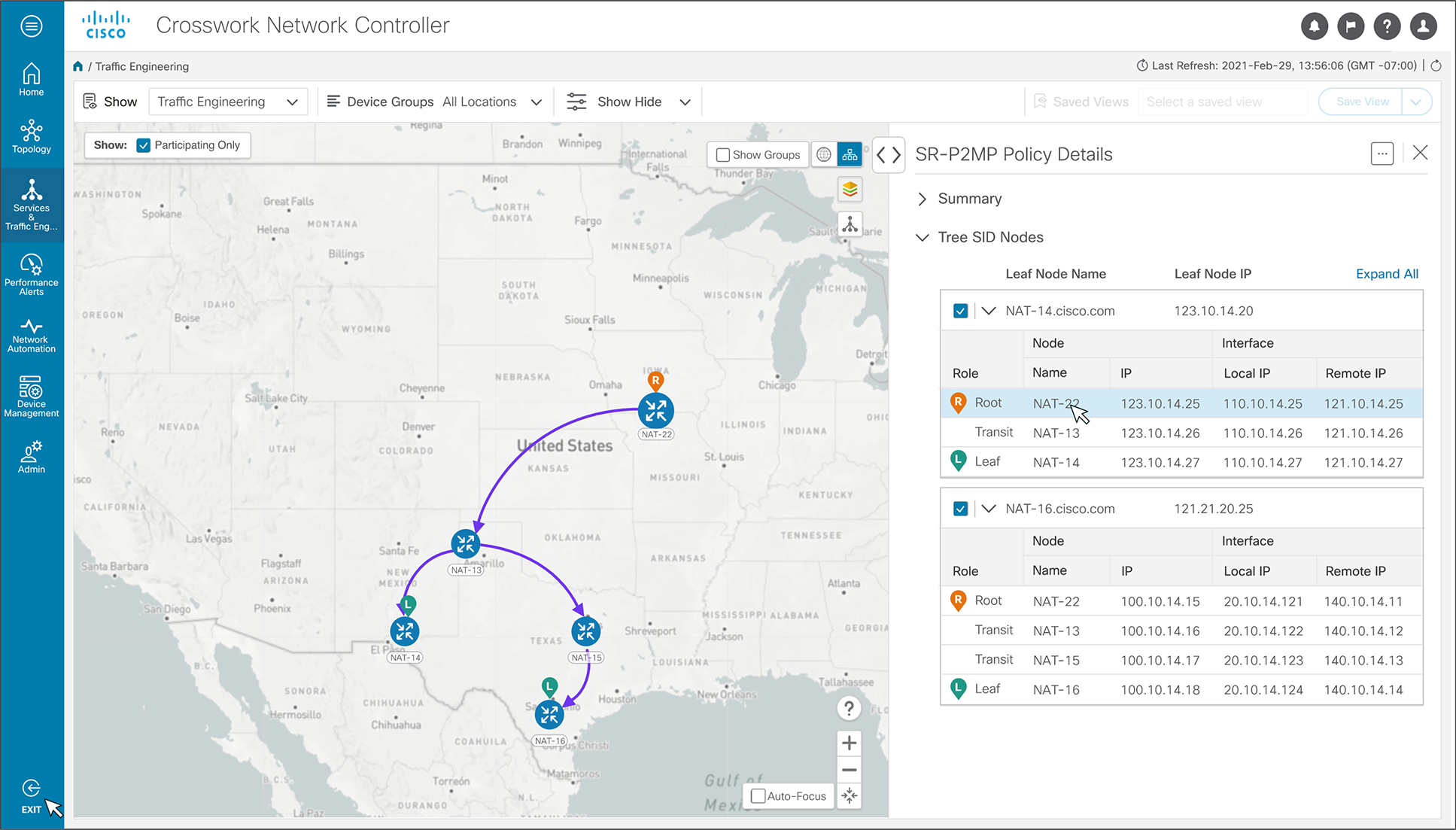
Example of a Tree-SID policy with policy details displayed on the Crosswork Optimization UI
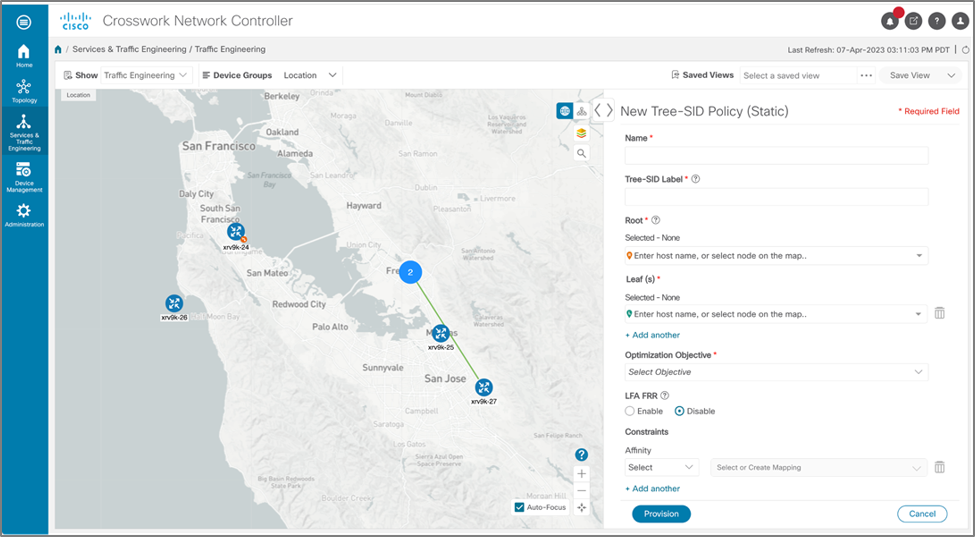
Example of Tree-SID provisioning UI
Simplified workflow for SR -TE policies and RSVP-TE tunnel lifecycle management
Crosswork Optimization Engine also provides an easy-to-use UI to manage the SR-TE policies and RSVP-TE tunnel lifecycle. The UI enables the network operator to:
1. Create, modify, and remove SR-TE policies or RSVP-TE tunnels using an intuitive workflow.
2. Continuously track SR-TE policies and RSVP-TE tunnels dynamic path computations to maintain SLA objectives.
3. Preview an SRTE policy or RSVP-TE tunnel before deploying it to the network.
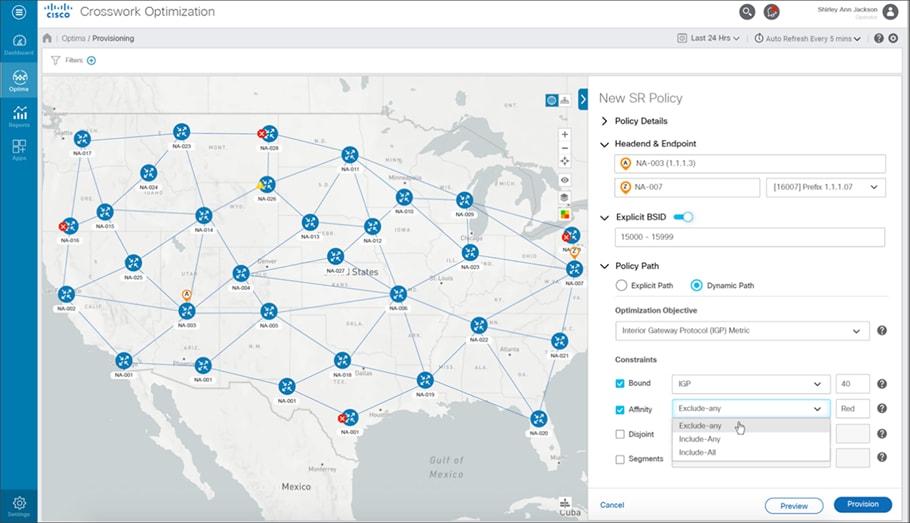
SR Policy Provisioning screen in Crosswork Optimization Engine
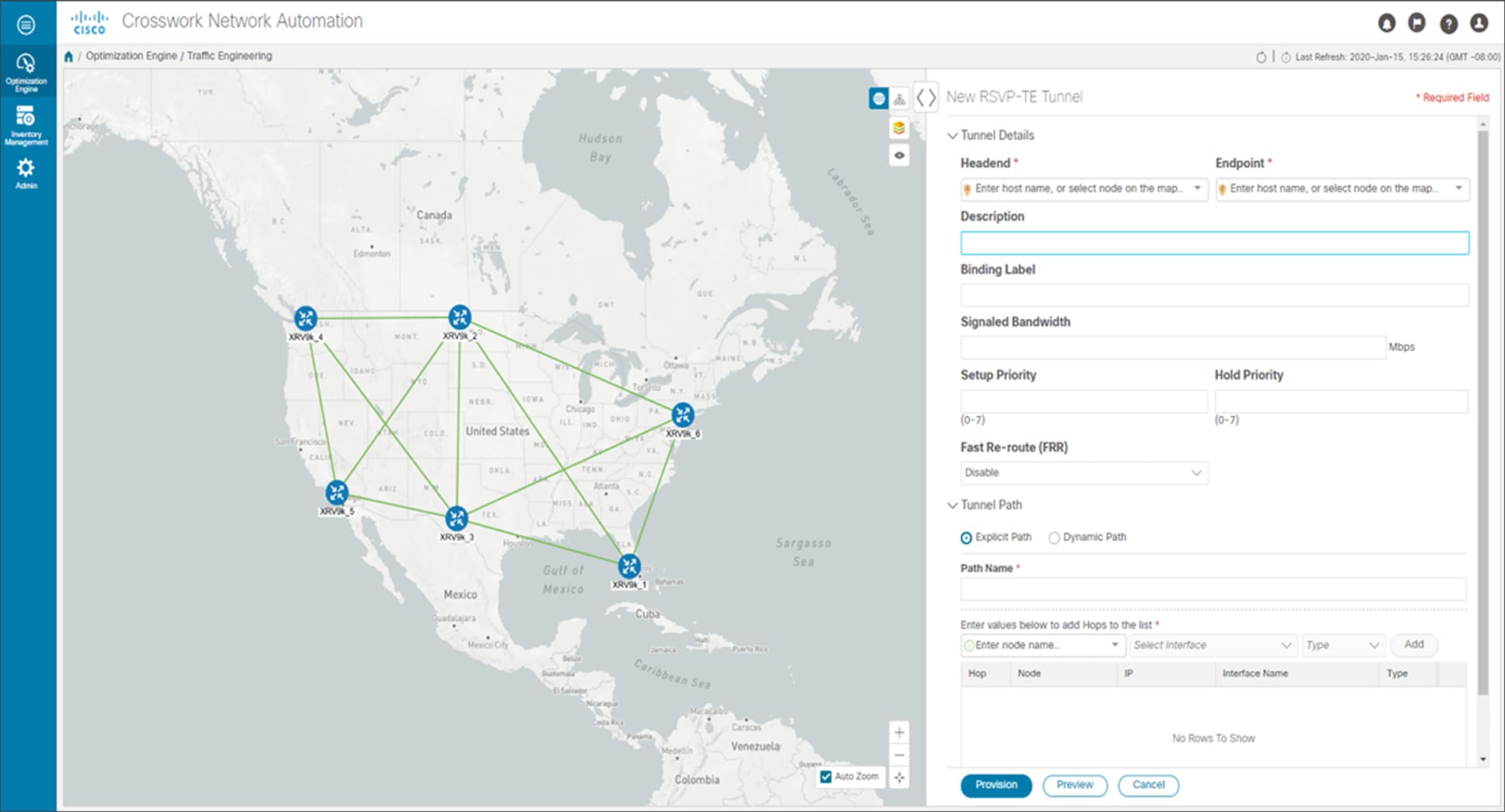
Details to enter to provision a new RSVP-TE tunnel from the Crosswork Optimization Engine GUI
Bandwidth management feature packs:
The Crosswork Optimization Engine feature packs allow users to augment their traffic engineering operations and include bandwidth use cases or preserve bandwidth as an intent in the network. With Crosswork Optimization Engine 7.0, the following bandwidth management capabilities with feature packs are offered:
1. Bandwidth on Demand:
As the name suggests, Bandwidth on Demand allows an operator/user to provision a Segment Routing Traffic Engineering (SR-TE)–based policy with a requested bandwidth between a specific set of devices. It is a soft bandwidth guarantee and can include a secondary optimization objective such as latency/TE/IGP.
2. Local Congestion Mitigation (LCM):
Local Congestion Mitigation resolves congestion issues at the local interface level. This is done by rerouting traffic via tactical SR-TE policies only between devices on either side of the congested link. This way, the mitigation is localized to the congested interface and the end-to-end policy is not rerouted. This feature allows two modes of operation – one for operators to regain some control of the network by introducing a human in the loop and an automatic mode in which the system automatically takes mitigation actions. Upon congestion detection, mitigation recommendations are provided to the user and applied to the network. It can also be used as a monitoring tool to understand long-term congestion and failure patterns in the network, which will enable operators to augment capacity or perform maintenance in the identified parts of the network.
For more information please refer to the LCM Whitepaper at: https://www.cisco.com/c/en/us/products/collateral/cloud-systems-management/crosswork-network-automation/local-congestion-mitigation-wp.html
3. SR Circuit Style Manager
Segment Routing Circuit-Style (SR Circuit-Style) is a new way to provide a predictable way to transport circuit-like services (Optical circuits, TDM) over a Segment Routing network. To do so, SR Circuit-Style provides a bandwidth management mechanism that will guarantee that a given service will get the necessary bandwidth along its path (and along its backup path). The Segment Routing policy itself is supposed to follow some strict rules when provisioned: explicit path only, co-routed, bi-directional (guaranteed latency), Bandwidth guaranteed, Fault protected and Diversity.
For more information please refer to the Circuit Style SR-TE Whitepaper at: https://www.cisco.com/c/en/us/products/cloud-systems-management/crosswork-network-automation/circuit-style-sr-te-wp.html
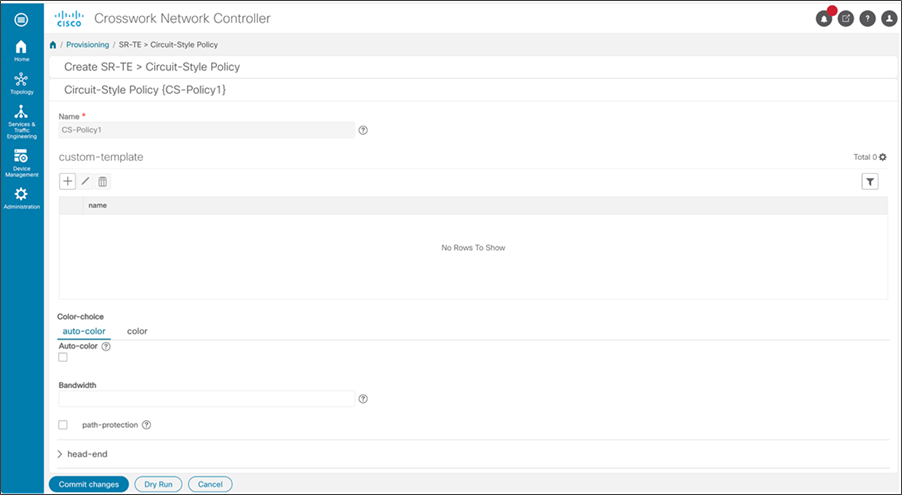
Provisioning an SR Circuit Style Policy
Talk to your Cisco Account Representative to see if these feature packs are right for your network.
Table 2. Standard protocol support: Key protocols
| Protocol |
Title |
| Path Computation Element (PCE) Communication Protocol (PCEP) |
|
| Path Computation Element Communication Protocol (PCEP) Extensions for Stateful PCE |
|
| Path Computation Element Communication Protocol (PCEP) Extensions for PCE-Initiated LSP Setup in a Stateful PCE Model |
|
| RSVP-TE: Extensions to RSVP for LSP Tunnels |
|
| Traffic Engineering Extensions to OSPF Version 2 |
|
| (IS-IS) Extensions for Traffic Engineering (TE) |
|
| RFC 7752 |
North-Bound Distribution of Link-State and Traffic Engineering (TE) |
| draft-ietf-spring-sr-replication-segment |
SR Replication Segment for Multi-point Service Delivery |
| draft-ietf-pim-sr-p2mp-policy |
Segment Routing Point-to-Multipoint Policy |
| draft-ietf-pce-sr-p2mp-policy |
Segment Routing Point-to-Multipoint Policy PCEP extensions for p2mp sr policy |
Please reach out to your Cisco account representative for a detailed list of all supported RFCs and IETF drafts or more information.
Cisco Crosswork Optimization Engine has a SMART-enabled software subscription license. For more information, contact your Cisco account representative.
System requirements: Crosswork Optimization Engine in a multi node cluster
Table 3. Crosswork Optimization Engine 7.0 System Requirements
| System Resource Type |
Requirement Details |
| Hypervisor and vCenter |
● VMware vCenter Server 8.0 (U2c or later) and ESXi 8.0 (U2b or later)
● VMware vCenter Server 7.0 (U3p or later) and ESXi 7.0 (U3p or later)
Installation should be done from the Crosswork Installer |
| The data center host platform has to accommodate 3 VMs of the following minimum configuration. It is preferrable that the VMs are hosted on separate physical servers for diversity: vCenter:
● 12 vCPUs | 96 GB RAM Memory | 1 TB disk space
Note: The install allows VM Memory and CPU sizes to be adjusted, and re-adjusted post installation. Storage requirements vary based on factors such as the number of devices being supported and the type of deployment selected. Due to their performance, solid state drives (SSD) are preferred over traditional hard disk drives (HDD). If you are using HDD, the minimum speed should be over 15,000 RPM. The VM data store(s) need to have disk access latency of <10 ms or >5000 IOPS. SSD or high-performance disks are recommended.
● By default, enforcing a “hard” reservation for the VM’s resources, the requirement will be 12vCPUs, 100% memory (i.e., 96 Gb for Large) and a revised 18 GHz reservation per VM, up from the previous default of 24 Gb and 16 GHz.
|
|
| Network connections |
For production deployments, we recommend that you use dual interfaces, one for the Management network and one for the Data network. When the VMs are deployed on separate physical hosts, the network connectivity between the hosts needs to be a minimum of 10 Gbps. |
| IP addresses |
●
2 IP subnets for the Management and Data network with each allowing a minimum of 4 assignable IP addresses (IPv4 or IPv6). Each Crosswork VM requires an IP address from the Management and Data subnets, respectively. In addition, the installation as a whole requires one Virtual IP (VIP) address from the Management and Data subnets, respectively. The total number of IP addresses on each subnet is 4, making for a total of 8 IP addresses across the two subnets.
●
Note:
When deploying a IPv6 cluster, the installer needs to run on an IPv6-enabled container/VM.
●
Note:
At this time, your IP allocation is permanent and cannot be changed without redeployment. For more information, contact your Cisco Customer Experience team.
|
| Upgrade requirements |
Upgrade of a Crosswork cluster of ‘N’ UCS will require ‘N+1’ UCS for the OVA upgrade. For example, in a cluster of 3 ‘nodes,’ an additional node will be needed for the upgrade, bringing the total to 4 ‘nodes’ or UCS. The additional node is just temporary for the duration of the upgrade to facilitate the upgrade. Post upgrade, a cluster of N nodes will continue with the same number of nodes/resources. |
System requirements: Crosswork Data Gateway as a collector for Crosswork Optimization Engine
Table 4. Crosswork Data Gateway System Requirements
| System Resource Type |
Requirement Details |
|||
| Hypervisor and vCenter |
● VMware vCenter Server 8.0 (U2c or later) and ESXi 8.0 (U2b or later)
● VMware vCenter Server 7.0 (U3p or later) and ESXi 7.0 (U3p or later)
Note: Installation should be done only from vCenter. |
|||
| Memory |
●
Standard: 48 GB
●
Extended: 112 GB
|
|||
| Disk space |
●
Standard: 60 GB (minimum)
●
Extended: 56 0 GB (minimum)
|
|||
| CPU |
●
Standard: 12
●
Extended: 20
|
|||
| Interfaces |
●
Minimum: 1
●
Maximum: 3
Crosswork Data Gateway can be deployed with either 1, 2, or 3 interfaces as per the combinations below: Note: The installation process asks only for vNIC0 and vNIC1 IP. vNIC2 IP is assigned during Crosswork Data Gateway pool creation as explained in the section “Create/Edit a Crosswork Data Gateway Pool” in your Crosswork application's Administration Guide. |
|||
| No. of NICs |
vNIC0 |
vNIC1 |
vNIC2 |
|
| 1 |
●
Management Traffic
●
Control/Data Traffic
●
Device Access Traffic
|
- |
- |
|
| 2 |
●
Management Traffic
|
●
Control/Data Traffic
●
Device Access Traffic
|
- |
|
| 3 |
●
Management Traffic
|
●
Control/Data Traffic
|
●
Device Access Traffic
|
|
| Management traffic: For accessing the UIs and command line and passing Control/Data information between servers (for example, a Crosswork application to Crosswork Data Gateway or NSO). Control/Data traffic: For data and configuration transfer between Crosswork Data Gateway and Crosswork applications and other external data destinations. Device access traffic: For device management (NSO or a Crosswork application to the devices as a result of KPI configuration or playbook execution) and telemetry data being forwarded to the Crosswork Data Gateway. When the VMs are deployed on separate physical hosts, the network connectivity between the hosts needs to be a minimum of 10 Gbps. |
||||
| IP addresses |
1, 2, or 3 IPv4/IPv6 addresses based on the number of interfaces you choose to use. |
|||
Please contact your Cisco account representative for details regarding ordering Cisco Crosswork Optimization Engine.
Cisco offers a wide range of services to help accelerate your success in connecting to Cisco Crosswork. The innovative Cisco Services offerings are delivered through a unique combination of people, processes, tools, and partners and are focused on helping you increase operational efficiency and improve your network control. Cisco Advanced Services use an architecture-led approach to help you align your network infrastructure with your business goals and achieve long-term value. Cisco Crosswork products can be combined with the Cisco SMARTnet™ service to help you resolve mission-critical problems with direct access at any time to Cisco network experts and award-winning resources. Spanning the entire network lifecycle, Cisco Services offerings help increase investment protection, optimize network operations, support migration operations, and strengthen your IT expertise. For more information, please visit www.cisco.com/go/services.
Flexible payment solutions to help you achieve your objectives
Cisco Capital makes it easier to get the right technology to achieve your objectives, enable business transformation and help you stay competitive. We can help you reduce the total cost of ownership, conserve capital, and accelerate growth. In more than 100 countries, our flexible payment solutions can help you acquire hardware, software, services and complementary third-party equipment in easy, predictable payments. Learn more.
Speak to your sales representative to learn more or schedule a demonstration.
Table 5. Document history
| New or Revised Topic |
Described In |
Date |
| Updated Features and Benefits |
January 2022 |
|
| Updated Local Congestion Mitigation |
January 2024 |
|
| Updated Release Version |
January 2024 |
|
| Updated System Requirements |
September 12, 2024 |